Ghost Knight: Reading and Exhibition Opening at Isny
In September 2011, Cornelia and German painter and illustrator Friedrich Hechelmann opened the exhibition of the original illustrations of Cornelia’s new book Ghost Knight.
Friedrich Hechelmann and Cornelia. They met at the exhibition opening in Isny for the first time and got along straightaway as if they had been friends for years. Maybe it's because a long time before their first meeting they got to know and got into each other's art so intensely. Sometimes, then, one gets the feeling to meet the artists in the stories they have written or the paintings they have created. Anyway, Cornelia and Friedrich Hechelmann liked each other immediately. Just look at their mutual smiling ...
Friedrich Hechelmann's illustrations of Cornelia's Ghostknight-story: the water colour paintings of the German painter and illustrator are currently being shown at Isny Castle Art Gallery. All 22 originals are hanging along a hallway on the second floor, and next to each of them a little label refers to the text passage that inspired the artist to paint that scene: the boy Jon Whitcroft sadly sitting aboard a train, because his mother shunted him off to boarding school, the three bone-pale ghosts on their ghost horses, who one night haunt Jon and seek his life, Zelda, the ghost expert with her dishevelled hair, the dead knight William Longspee, who in the cathedral's darkness rises from his coffin to come to the aid of the boy, who begged him on his knees to help him ... Friedrich Hechelmann took one year to tell the story of Jon Whitcroft and the ghostknight William Longspee with his "haunting" water colours.
It had rained cats and dogs again, and actually it was impossible to sneak away during homework time. At least if one does not want to run into big trouble. Yet that trouble is nothing compared to being chased by four bloodthirsty ghosts. So Jon slipped away to meet Zelda Littlejohn, Ella's grandmother, who lived not far from Salisbury Cathedral. There were many rumors about that old lady: that she was not all there, a bit round the bend, that there were packs of toads hopping around in her house, and that she dealt with ghosts, maybe that she was even a witch. Zelda Littlejohn's house lies near an old mill, right behind the soggy meadows, and through its cast-iron garden gate you have a very good view to the cathedral.
"The garden gate was jammed shut and when I finally managed to push it open I actually saw two toads jumping away. A third one was sitting on the doormat. It looked at me through its amber eyes as if it had never seen anything as strange as me." (Ghostknight, pp 54-55)
Jon feels queasy. Inside the huge cathedral it is dark and it smells of candle wax. Legs like jelly, he approaches one of the numerous tombs. On a wooden pedestal lies the figure of a knight with his hand on his sword hilt and the lion crest buckler on his chest, his head turned slightly to the left. It seems as if he had just fallen asleep, as if he could wake up any minute. And that's exactly what Jon is hoping for: to revive a dead knight after hundreds of years by his cry for help. Jon feels silly when he falls to his knees in front of the tomb and with feeble voice starts speaking into the dark. "Please!" I heard myself whisper. The words came out by themselves.
"'Please, William Longspee, help me.' Suddenly I heard steps. Rattling steps, as if made by iron shoes. I turned around. And there he was. ... He was taller than I'd expected, and his chainmail shimmered as if the moon himself had made it for him." (Ghostknight, pp 89-90)
Bizarre, crazy, funny: The picture of Ella and the dog in front of the dolmens of Stonehenge is different from the many murky Ghostknight motifs, but just because of this it matches so well, since the story's not spooky throughout as well. Ella and Jon sitting in the backseat, a dog and a fat toad sitting in a basket in the front seat, her sprained foot wrapped in loads of bandages: that's how granny Zelda set out to Stonehenge in her age-old car. Stonehenge, where Ella and Jon suspect to find the hidden heart of ghostknight Wiliam Longspee. But where should they look for it, for nobody was allowed to get too close to those ancient stones? Well, that's why little dog Wellington, the fat nameless toad and grandma Zelda came along to help.
"We found Zelda surrounded by very agitated Russians, Chinese and Canadians, who were all terribly concerned for the poor old lady who'd nearly lost her dog in Stonehenge. Somebody had even rustled up a chair for her. Wellington was sitting on her lap, his tongue nearly hanging down to his paws, clearly enjoying all the attention." (Ghostknight, p 156)
This picture is one of Cornelia's favorites. It shows the dead chorister Aleister Jindrich. Aleister went to the same boarding school as Jon, and one night he fell to death out of one of the school's windows. There were rumors that he had been pushed, but that has never been cleared up. When Jon adjourns to the school chapel, because he wants to be alone for a while, the ghost of the dead chorister appears to him. Small, skinny and translucent, with a cat-like face marked by malignity and furtiveness. He waited for Jon to plant doubt in his mind: could that meanie's claims be true, could he be right in stating that William Longspee is a cold-blooded murderer, the murderer of those who beg him for help?
"My counterpart sneered. I could see through his face like through tattered cloth. 'Don't play stupid. I bet you my place in hell that he asked the same price of you that he asked of me. Am I right?' He laughed. It sounded awful, and his face very quite literally nearly dissolved into laughter." (Ghostknight, p 170)
When Jon begins to struggle against the ghosts that are after him, he also endangers those he loves. The nasty Lord Stourton and his anaemic helpers have caught Jon's friend Ella. Jon got to know Ella at his school and when they met for the first time, he turned as pink as ghosts are pale, because Ella looks so pretty and is far from shy. Ella and her quirky grandmother Zelda — she's got hair like an unkempt bird — tell Jon what's up with that ghost that is haunting him, and it is them who encourage him to ask the dead knight William Longspee to help him get rid of Lord Stourton's ghost. Though never mess with Stourton: When Ella suddenly disappears, her grandmother shows Jon a letter, which affirms his worst fears. If they wanted to see her alive again, hee and Zelda should come to Kilmington cemetery.
"It was a cold night. Fog had gathered between the gravestones, white and damp, as though the dead were exhaling beneath the turf. Four men were waiting in the haze. It was immediately obvious that there was something wrong with them. ... one of them turned and dragged Ella out from behind a gravestone... the pale rider, who had filled so many of my days and nights with terror, leapt over the cemetery's gate. This time he was surrounded by light. Unlike Longspee's, however, his light made the fog glow in a filthy green, like mould on rotting bread." (Ghostknight, pp 209-212)
Cornelia coming out of Isny Castle Art Gallery, where she has seen the original illustrations of her new book Geisterritter (Ghostknight) for the very first time.
The exhibition banner shows Ella with the dead chorister Aleister Jindrich. Painter and illustrator Friedrich Hechelmann chose exactly this motif, since it also works when seen from a distance. Slyly like the Cheshire Cat from Alice in Wonderland, that's how he is described in the book.
The dead chorist, whom Ella and Jon have to trick to find Longspee's heart. So Friedrich Hechelmann illustrated that crooked, little Aleister with a face that looks as if a snarling cat's head can be traced through the boy's unappealing face.
The kursaal at Isny was packed with children and their parents to listen to Cornelia's reading. The reading started and in the hall it got as dark as inside Salisbury Cathedral. Cornelia had chosen three passages from Geisterritter: the very beginning, Jon's nightly encounter with the ghosts and the passage when Jon faces ghostknight William Longspee for the first time in the moon's shimmer inside Salisbury Cathedral. The reading was finished too soon and the question time was too short — for sure the audience could have listened much longer, and for sure Cornelia could have read more pages and answered more questions (Cornelia, are you rich? Since when do you live in the USA? What was your very first book called?). Fortunately the exhibition of the Geisterritter illustrations opened directly after the reading, and so Cornelia, Friedrich Hechelmann and most of the reading visitors moved on to Isny Castle to see the pictures.
Before Cornelia starts reading from her book Ghostknight, she tells the audience about William Longspee and his wife Ella of Salisbury. For her new story she had researched a lot locally in Salisbury and also in history books. "Ella was the first female sheriff of Salisbury. I was quite impressed that there was such thing in 1137. Ella adored his husband. When he was missed after a naval battle, they wanted to force her into marriage with another man, because she was such a powerful woman. Ella, though, made history as the first woman to rely on the Magna Charta and refused marriage until William returned. When he came back , they celebrated. Two weeks later he was dead. It was rumored that he had been poisoned.
Ella took his heart and rode to Lacock to found an abbey ... What fantastic material for a story, isn't it?" And certainly every ghost story is a little better when it is not completely made up, just like the ghostknight story is based on some true events. Even though, is there a passage at all which is only imaginary?
Question time after the reading. Were you good at school?, a boy asks. Cornelia does not have to think twice to remember. German, English and History were my favourite subjects, Cornelia answers. I was a benchwarmer in P.E. class and in Chemistry I spiraled continually downward. And what about writing? , asks another boy. What about writing at your school then? Oh yes, I liked writing German class essays, I got started on it and filled the pages. On hand-in day, I was always told: Cornelia, that was really good, a great essay, and I really liked the text, but you missed the topic again.
Before the exhibition opened for the public, Friedrich and Cornelia had viewed the original illustrations together. Standing in front of the paintings, Cornelia was visibly impressed. Much to Friedrich Hechelmann's relief. Cornelia loves them so much that she has even bought two of them.
Later, on their way to the kursaal, where Cornelia did a big reading from her new book Geisterriter, a camera crew followed them at every turn.
The refectory on the ground floor of Isny Castle was crammed with people that just some ghosts would have found some room by floating below the baroque ceiling. Many visitors were standing in the aisles and outside in front of the windows trying to get a glimpse of Cornelia and Friedrich. On this photo they are just listening to a musician, who accompanied the exhibition opening with his lute. Cornelia and Friedrich like lute music and sometimes listen to it while writing and illustrating.
Cornelia and Friedrich didn't mind the TV camera behind them. They were talking about how stories bring about pictures in the reader's mind and how pictures in turn can tell the viewers stories. "Actually I don't read these kinds books", Friedrich Hechelmann admitted to Cornelia, but when he had got the manuscript of Geisterritter, he immediately had been stoked by the story about the boarder Jon Whitcroft and the ghostknight William Longspee.As soon as he had read the first lines, they transformed into fantastic pictures. Cornelia couldn't barely believe that Friedrich has never been to England: "The way he has painted the cathedral in the fog, it's exactly what it looks like when the moon is shining and fog is wafting over those meadows around the cathedral that once were a graveyard.“
Both, Cornelia and Friedrich, had fun at the exhibition. Before their signing of countless books that visitors had brought, they first signed the "guestbook" of Isny Castle. Each of them made a short speech and told the audience that they both had been really looking forward to making a beautiful book together. Cornelia had always dreamed of having one of her stories illustrated in the fantastic and luxuriant way of the ancient storybooks she had so much loved as a child. She told her German publisher and they suggested the painter and illustrator Friedrich Hechelmann, who himself was surprised by this, because he had not read any of Cornelia's stories by then. And Cornelia was pleasantly surprised, for she thought that there couldn't be any better choice and for she never expected her dream to come true so quickly by Friedrich's luminous, spooky and funny pictures.
"Sehr glücklich über dieses Fest zu Ehren von Friedrich Hechelmanns wunderbaren Bildern" ("Very happy about this festivity in honor of Friedrich Hechelmann's wonderful pictures"), Cornelia has written in the Isny Castle Art Gallery's big book and below these lines she made Firedrake fly across the page. On her way back from a Swedish bookfair, Cornelia made a detour to Isny just for the reading and the exhibition opening and to get to know Friedrich Hechelmann finally.
Cornelia is drawing her dragon in the gallery's visitors' book and Friedrich is watching, his face revealing that he is at least as happy about the event as Cornelia. Books to be signed were handed to Cornelia and Friedrich every second and autographs were much sought after. People brought their copies of Ghostknight, Reckless, Dragon Rider.
Cornelia has no idea how many books she signed at that late afternoon. It's been so many that she had difficulties holding her knife at dinner later on. Her hand was too tired. Cornelia loves to sign her readers' books and she so much regrets that time is always too short to add a little dedication or drawing to each signature. If she had, in Isny Castle people would no doubt still be standing in line for their autograph.
Friedrich Hechelmann is signing "Zwerg Nase" (Little Longnose), the very first storybook he had illustrated. It was published in 1972, shortly after he had completed his studies of art in Vienna. Today he lives and works in the Allgäu, where he was born. He has not only been illustrating books so far, but has also written screen-plays for TV, worked as an artist for opera and theatre productions and painted huge panels which can also be viewed at Isny Castle Art Gallery. Even St. Petersburg's world-famous museum The Hermitage once dedicated an exhibition to his work and has bought one of his illustrations. Commemorating the 80th birthday of children's book author Michael Ende, Friedrich also illustrated a new edition of Momo, which came out in 2009.
Together we will make it: Would you like to sign first or should I? Oh, Friedrich Hechelmann would answer, your writing looks much better than mine, and would defer to her. Luckily, the two had already viewed the exhibition in the afternoon before Cornelia's reading, for they wouldn't have found time after the visitors' inrush in the evening.
The morning after the exhibition opening, Cornelia paid a visit to Friedrich's studio, which is only five minutes by car from Isny Castle. The 63-year-old painter and illustrator is enthused about classical music and literature as much as for painting.
Sitting outside in the sun at Friedrich's studio house, the two are talking about how the view outside one's study's window brings forward new ideas, and Cornelia tells about the wonderfully crazy people of Beverly Hills and Hollywood. "In the past, I sometimes felt like the odd one out", she says, "now I feel like an odd one out amidst a flock of odd ones out. It's not unlikely to drive around and pass a pink convertible driven by an old film director with a blonde wig. In LA you are free to be what you want to be." Being as crazy as you like without being sneered at. Friedrich Hechelmann knows directly what she means. "Did you know that West Hollywood police have rainbows painted on their cars? Can you fancy that?!"
Friedrich Hechelmann's garden is filled with rose bushes, lemon trees and all kinds of wild flowers. A fountain is purling and cowbells are ringing in the distance.
His garden and his studio at The Rose House are retreat and, at the same time, inspiration, and one suspects little goblins hiding behind the bushes and striding through the chest high grass.
Text and photos: Michael Orth
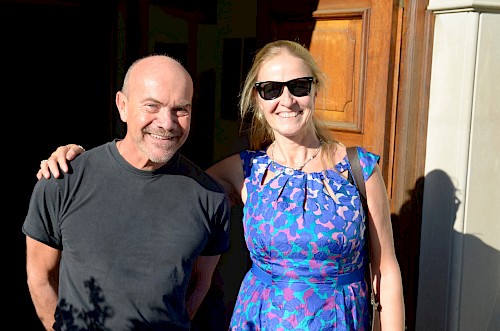
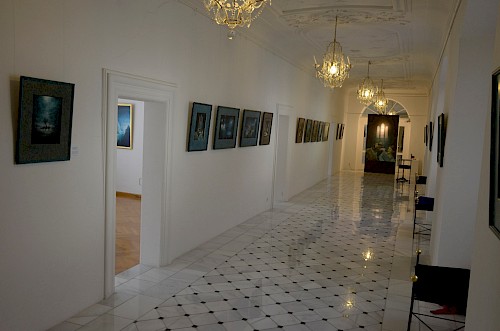
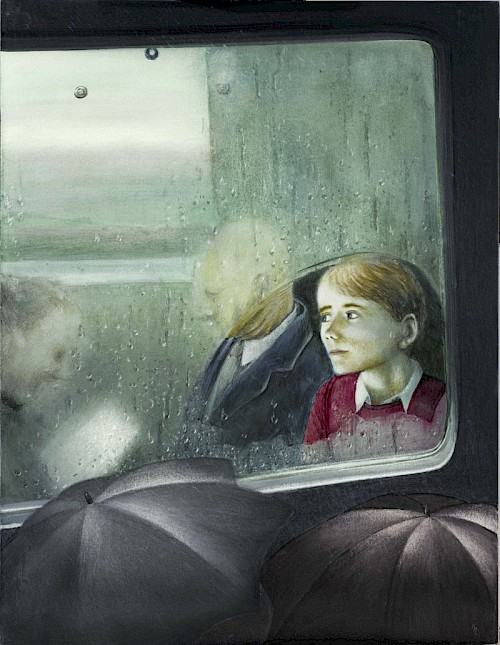

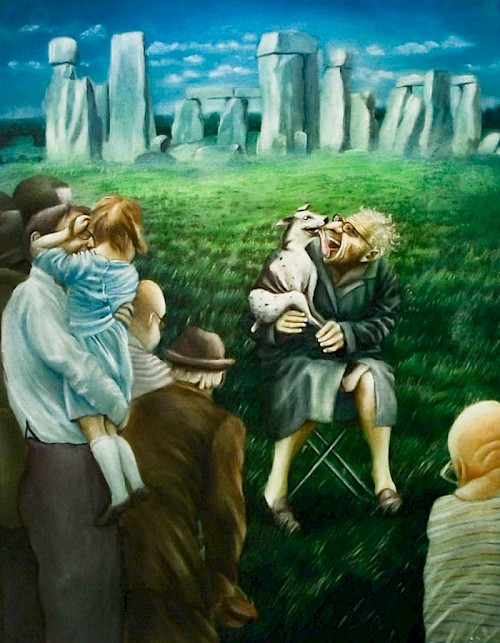


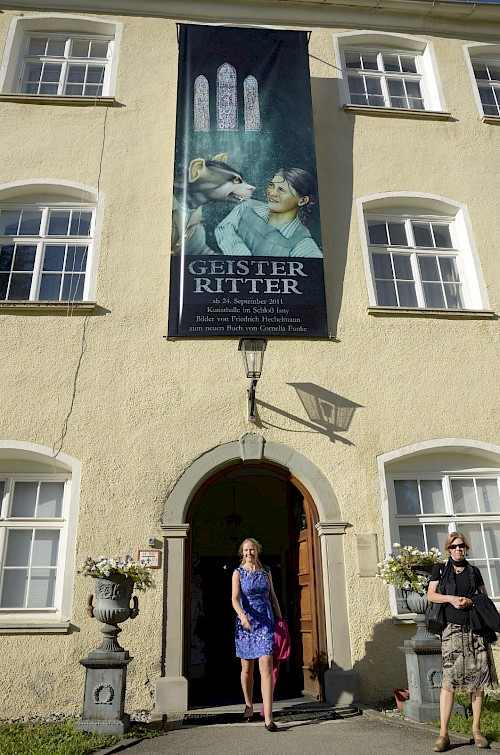
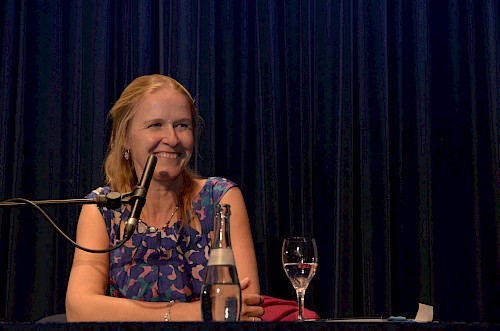
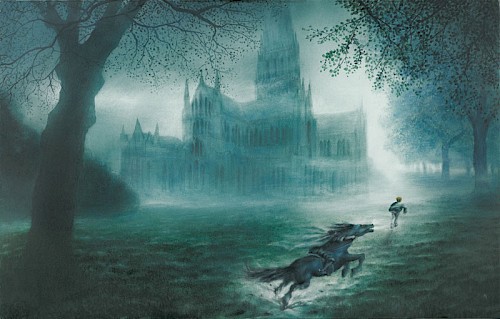
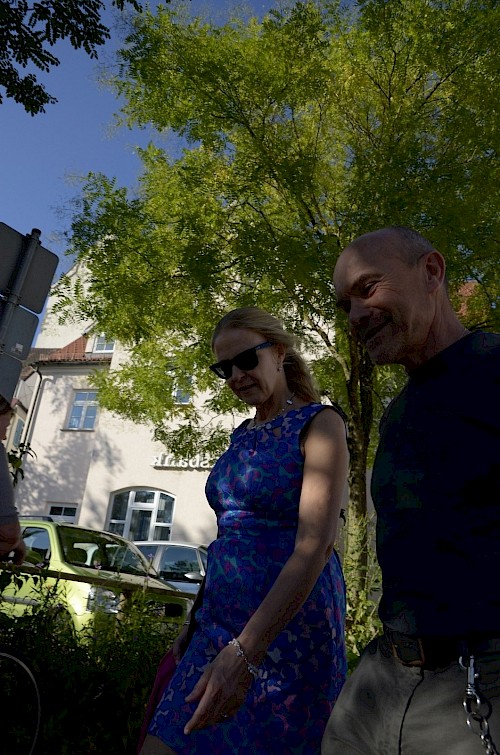

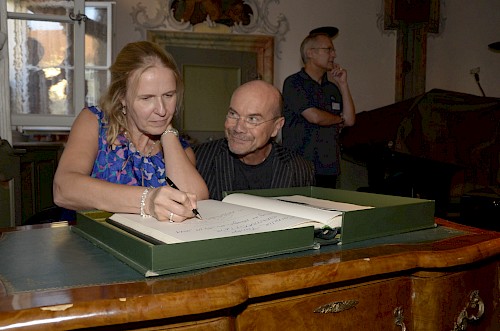
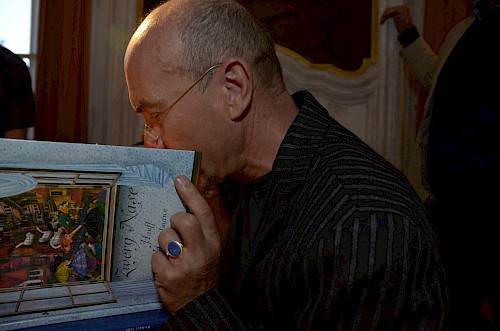




No comments
Leave a comment